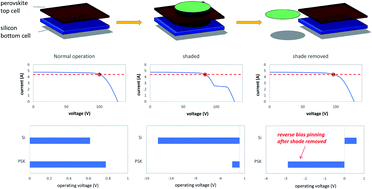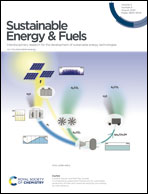Destructive reverse bias pinning in perovskite/silicon tandem solar modules caused by perovskite hysteresis under dynamic shading†
Abstract
We demonstrate how perovskite hysteresis can result in permanent reductions in power output in perovskite/silicon tandem modules—including irreversible hotspot-induced damage—from only brief periods of shading. We show that reverse bias events in which a perovskite cell is biased above a threshold voltage—which in this work we find to be as low as −1.1 V—produces a temporary reduction in power output that is of sufficient magnitude to keep the cell pinned in reverse bias after the shading event ends. As a hysteretic phenomena, this crucial failure mode may be overlooked by static models of perovskite-based solar cells. Higher reverse bias voltages exacerbate the temporary reduction in short-circuit photocurrent, which is also sensitive to the level of illumination under reverse bias. Numerical device modelling demonstrates that this effect is consistent with our understanding of perovskite hysteresis as a consequence of mobile ion-electron coupling controlling rates of non-radiative recombination over time. Measurements of the dynamic response of single-junction perovskite cells are extrapolated to two-terminal and four-terminal perovskite/silicon tandem module modelling. We validate these models with measurements from an equivalent electronic circuit that represents a two-terminal perovskite–silicon tandem mini module. Two module-level solutions are discussed that address this issue, which includes increasing the number of bypass diodes and choosing better suited silicon bottom cells with higher shunter resistance in two-terminal tandem modules.



 Please wait while we load your content...
Please wait while we load your content...